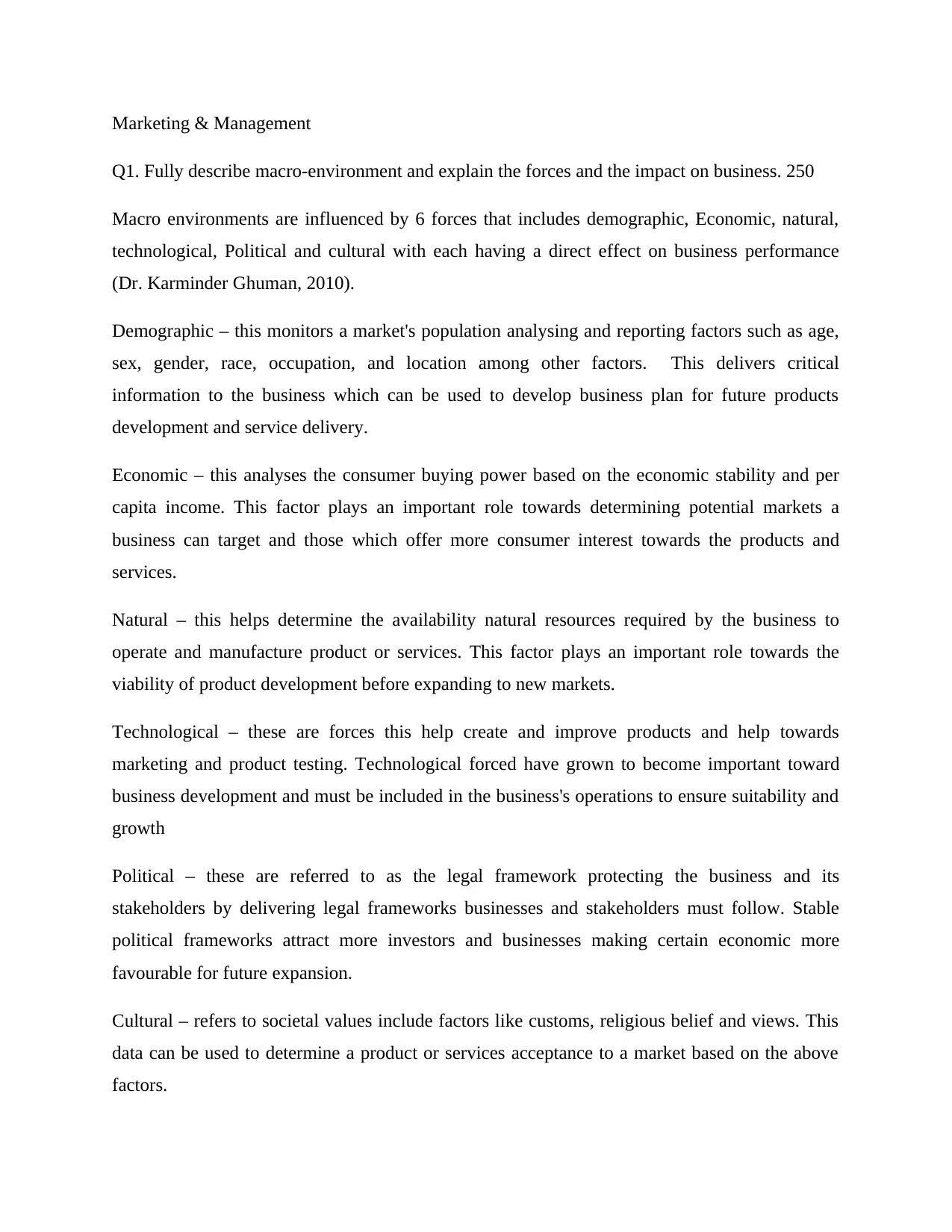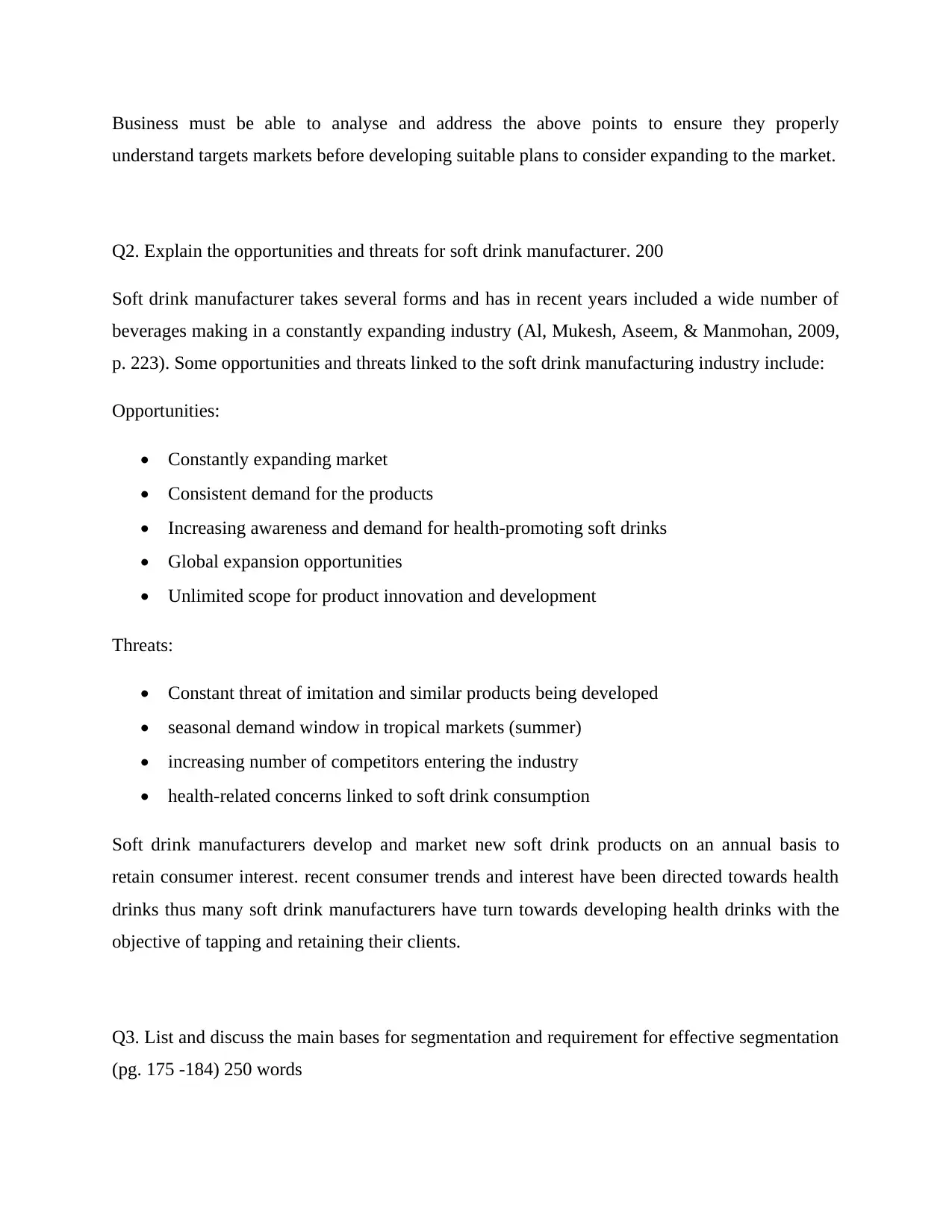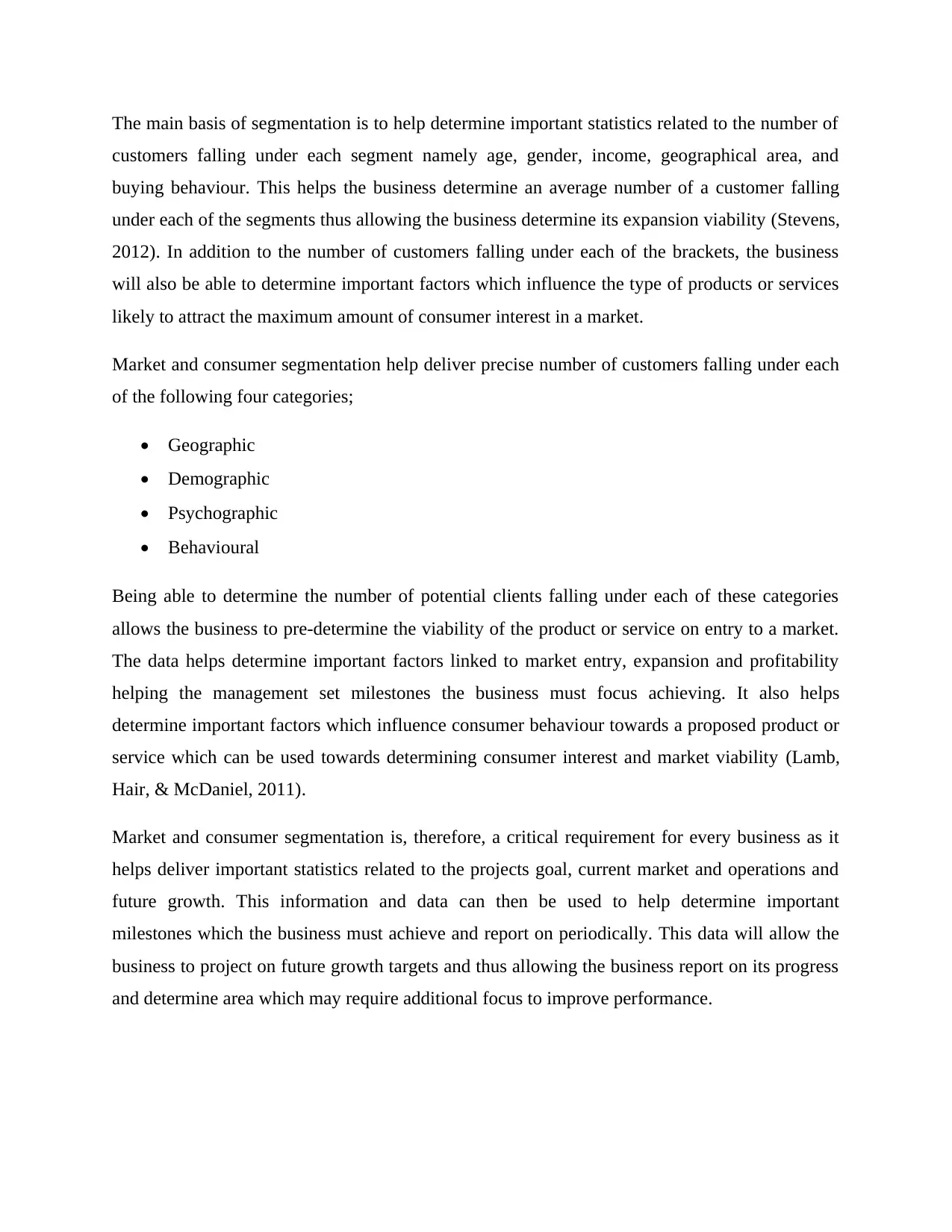Understanding Macro-Environment and Market Segmentation in Business
VerifiedAdded on 2020/05/11
|4
|977
|48
AI Summary
The assignment addresses critical aspects of marketing and management, focusing on the macro-environment's influence on businesses through demographic, economic, natural, technological, political, and cultural forces. It elucidates how these elements can affect a company's strategy and performance. Specifically, it explores opportunities and threats faced by soft drink manufacturers, emphasizing market expansion, health trends, competition, and consumer preferences. Additionally, the assignment outlines key bases for effective market segmentation such as geographic, demographic, psychographic, and behavioral factors, highlighting their significance in assessing market viability and setting strategic milestones for business growth.

Marketing & Management
Q1. Fully describe macro-environment and explain the forces and the impact on business. 250
Macro environments are influenced by 6 forces that includes demographic, Economic, natural,
technological, Political and cultural with each having a direct effect on business performance
(Dr. Karminder Ghuman, 2010).
Demographic – this monitors a market's population analysing and reporting factors such as age,
sex, gender, race, occupation, and location among other factors. This delivers critical
information to the business which can be used to develop business plan for future products
development and service delivery.
Economic – this analyses the consumer buying power based on the economic stability and per
capita income. This factor plays an important role towards determining potential markets a
business can target and those which offer more consumer interest towards the products and
services.
Natural – this helps determine the availability natural resources required by the business to
operate and manufacture product or services. This factor plays an important role towards the
viability of product development before expanding to new markets.
Technological – these are forces this help create and improve products and help towards
marketing and product testing. Technological forced have grown to become important toward
business development and must be included in the business's operations to ensure suitability and
growth
Political – these are referred to as the legal framework protecting the business and its
stakeholders by delivering legal frameworks businesses and stakeholders must follow. Stable
political frameworks attract more investors and businesses making certain economic more
favourable for future expansion.
Cultural – refers to societal values include factors like customs, religious belief and views. This
data can be used to determine a product or services acceptance to a market based on the above
factors.
Q1. Fully describe macro-environment and explain the forces and the impact on business. 250
Macro environments are influenced by 6 forces that includes demographic, Economic, natural,
technological, Political and cultural with each having a direct effect on business performance
(Dr. Karminder Ghuman, 2010).
Demographic – this monitors a market's population analysing and reporting factors such as age,
sex, gender, race, occupation, and location among other factors. This delivers critical
information to the business which can be used to develop business plan for future products
development and service delivery.
Economic – this analyses the consumer buying power based on the economic stability and per
capita income. This factor plays an important role towards determining potential markets a
business can target and those which offer more consumer interest towards the products and
services.
Natural – this helps determine the availability natural resources required by the business to
operate and manufacture product or services. This factor plays an important role towards the
viability of product development before expanding to new markets.
Technological – these are forces this help create and improve products and help towards
marketing and product testing. Technological forced have grown to become important toward
business development and must be included in the business's operations to ensure suitability and
growth
Political – these are referred to as the legal framework protecting the business and its
stakeholders by delivering legal frameworks businesses and stakeholders must follow. Stable
political frameworks attract more investors and businesses making certain economic more
favourable for future expansion.
Cultural – refers to societal values include factors like customs, religious belief and views. This
data can be used to determine a product or services acceptance to a market based on the above
factors.
Paraphrase This Document
Need a fresh take? Get an instant paraphrase of this document with our AI Paraphraser

Business must be able to analyse and address the above points to ensure they properly
understand targets markets before developing suitable plans to consider expanding to the market.
Q2. Explain the opportunities and threats for soft drink manufacturer. 200
Soft drink manufacturer takes several forms and has in recent years included a wide number of
beverages making in a constantly expanding industry (Al, Mukesh, Aseem, & Manmohan, 2009,
p. 223). Some opportunities and threats linked to the soft drink manufacturing industry include:
Opportunities:
• Constantly expanding market
• Consistent demand for the products
• Increasing awareness and demand for health-promoting soft drinks
• Global expansion opportunities
• Unlimited scope for product innovation and development
Threats:
• Constant threat of imitation and similar products being developed
• seasonal demand window in tropical markets (summer)
• increasing number of competitors entering the industry
• health-related concerns linked to soft drink consumption
Soft drink manufacturers develop and market new soft drink products on an annual basis to
retain consumer interest. recent consumer trends and interest have been directed towards health
drinks thus many soft drink manufacturers have turn towards developing health drinks with the
objective of tapping and retaining their clients.
Q3. List and discuss the main bases for segmentation and requirement for effective segmentation
(pg. 175 -184) 250 words
understand targets markets before developing suitable plans to consider expanding to the market.
Q2. Explain the opportunities and threats for soft drink manufacturer. 200
Soft drink manufacturer takes several forms and has in recent years included a wide number of
beverages making in a constantly expanding industry (Al, Mukesh, Aseem, & Manmohan, 2009,
p. 223). Some opportunities and threats linked to the soft drink manufacturing industry include:
Opportunities:
• Constantly expanding market
• Consistent demand for the products
• Increasing awareness and demand for health-promoting soft drinks
• Global expansion opportunities
• Unlimited scope for product innovation and development
Threats:
• Constant threat of imitation and similar products being developed
• seasonal demand window in tropical markets (summer)
• increasing number of competitors entering the industry
• health-related concerns linked to soft drink consumption
Soft drink manufacturers develop and market new soft drink products on an annual basis to
retain consumer interest. recent consumer trends and interest have been directed towards health
drinks thus many soft drink manufacturers have turn towards developing health drinks with the
objective of tapping and retaining their clients.
Q3. List and discuss the main bases for segmentation and requirement for effective segmentation
(pg. 175 -184) 250 words

The main basis of segmentation is to help determine important statistics related to the number of
customers falling under each segment namely age, gender, income, geographical area, and
buying behaviour. This helps the business determine an average number of a customer falling
under each of the segments thus allowing the business determine its expansion viability (Stevens,
2012). In addition to the number of customers falling under each of the brackets, the business
will also be able to determine important factors which influence the type of products or services
likely to attract the maximum amount of consumer interest in a market.
Market and consumer segmentation help deliver precise number of customers falling under each
of the following four categories;
• Geographic
• Demographic
• Psychographic
• Behavioural
Being able to determine the number of potential clients falling under each of these categories
allows the business to pre-determine the viability of the product or service on entry to a market.
The data helps determine important factors linked to market entry, expansion and profitability
helping the management set milestones the business must focus achieving. It also helps
determine important factors which influence consumer behaviour towards a proposed product or
service which can be used towards determining consumer interest and market viability (Lamb,
Hair, & McDaniel, 2011).
Market and consumer segmentation is, therefore, a critical requirement for every business as it
helps deliver important statistics related to the projects goal, current market and operations and
future growth. This information and data can then be used to help determine important
milestones which the business must achieve and report on periodically. This data will allow the
business to project on future growth targets and thus allowing the business report on its progress
and determine area which may require additional focus to improve performance.
customers falling under each segment namely age, gender, income, geographical area, and
buying behaviour. This helps the business determine an average number of a customer falling
under each of the segments thus allowing the business determine its expansion viability (Stevens,
2012). In addition to the number of customers falling under each of the brackets, the business
will also be able to determine important factors which influence the type of products or services
likely to attract the maximum amount of consumer interest in a market.
Market and consumer segmentation help deliver precise number of customers falling under each
of the following four categories;
• Geographic
• Demographic
• Psychographic
• Behavioural
Being able to determine the number of potential clients falling under each of these categories
allows the business to pre-determine the viability of the product or service on entry to a market.
The data helps determine important factors linked to market entry, expansion and profitability
helping the management set milestones the business must focus achieving. It also helps
determine important factors which influence consumer behaviour towards a proposed product or
service which can be used towards determining consumer interest and market viability (Lamb,
Hair, & McDaniel, 2011).
Market and consumer segmentation is, therefore, a critical requirement for every business as it
helps deliver important statistics related to the projects goal, current market and operations and
future growth. This information and data can then be used to help determine important
milestones which the business must achieve and report on periodically. This data will allow the
business to project on future growth targets and thus allowing the business report on its progress
and determine area which may require additional focus to improve performance.
⊘ This is a preview!⊘
Do you want full access?
Subscribe today to unlock all pages.

Trusted by 1+ million students worldwide

Reference:
Al, C. E., Mukesh, C., Aseem, K., & Manmohan, r. (2009). Managing Innovation And New Product
Development: Concepts And Cases. Gurgoan: PHI Learning Pvt. Ltd.
Dr. Karminder Ghuman. (2010). Management: Concepts, Practice & Cases. New Delhi: Tata McGraw-Hill
Education.
Lamb, C. W., Hair, J. F., & McDaniel, C. (2011). Essentials of Marketing. Mason: Cengage Learning.
Stevens, R. E. (2012). Market Opportunity Analysis: Text and Cases. Birmington: Routledge.
Al, C. E., Mukesh, C., Aseem, K., & Manmohan, r. (2009). Managing Innovation And New Product
Development: Concepts And Cases. Gurgoan: PHI Learning Pvt. Ltd.
Dr. Karminder Ghuman. (2010). Management: Concepts, Practice & Cases. New Delhi: Tata McGraw-Hill
Education.
Lamb, C. W., Hair, J. F., & McDaniel, C. (2011). Essentials of Marketing. Mason: Cengage Learning.
Stevens, R. E. (2012). Market Opportunity Analysis: Text and Cases. Birmington: Routledge.
1 out of 4
Related Documents
Your All-in-One AI-Powered Toolkit for Academic Success.
+13062052269
info@desklib.com
Available 24*7 on WhatsApp / Email
![[object Object]](/_next/static/media/star-bottom.7253800d.svg)
Unlock your academic potential
Copyright © 2020–2025 A2Z Services. All Rights Reserved. Developed and managed by ZUCOL.





